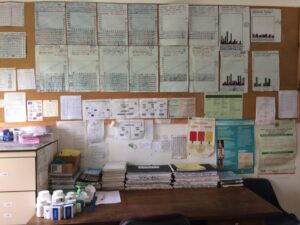RGH Video Blog – The Six Sigma Role of Health Professionals
Hello and welcome to the Global Health Video Class. My name is Dr. Elvira Beracochea and I am the president and CEO of Realizing Global Health. You can find us at http://www.realizingglobalhealth.com. We are a global health consultant company working to create self-reliant, sustainable health systems.
Today, we are talking about a very important approach that really can change global health when it’s applied to every country consistently. I really want to encourage you to join us in this movement that will bring Six Sigma to every country, everywhere. We really need to reduce the number of errors that we make in global health. We need to reduce the number of children who do not receive immunizations. We need to reduce the number of children who are not diagnosed and treated properly. We need to reduce the number of mothers who are delivering babies in conditions that are less than proper. We need to end the number of patients who do not get their medication or have to default on their treatment because the medicines are not there. We need to make sure that every patient gets the same quality of healthcare that we get in any country in the world, everywhere every day. How do we do that? We do that by applying Six Sigma.
Six Sigma is a methodology I have adapted to make sure that we make the effort to consistently deliver the highest attainable standard of quality healthcare to everyone every day everywhere. How? By putting standard operational procedures in place that are epidemiology-based, evidence-based and patient-centered. We have to remember that we are working with human beings and we need to treat patients as human beings with respect and dignity—because it is their human right.
Today, we are going to talk about how health professionals working in governments, NGOs, hospitals, clinics, etc. can deliver the highest attainable standard of quality healthcare to everyone everywhere every day. We do that because we started with the project. A project is designed to change the country’s programs. We know that programs are vertical to address different health problems, like HIV/AIDS or malaria, for example. Each country has a number of programs. Then, those programs are translated into services. The services are then translated to delivery processes. Again, the services need to be delivered in a certain way. There has to be standard operating procedures to make sure that the same quality of healthcare is being provided to every patient regardless of location.
Remember, we talked about Six Sigma and the importance of reducing errors to less than 3.4 per 1 million opportunities. We talked about the process of assessing, measuring, preventing, and making sure that we control how services are being delivered. We talked about how we can change services that are not up to standards. We start with a project that is defined to improve how that program in that country is working. Then, that program needs to be translated into services and those services need to be translated into delivery processes. I will talk more about this in following videos but I want you to remember that sequence.
Look at the projects that are taking place in your country or where you are working. Are they really improving the country’s programs? If we use malaria as an example, are the projects having an impact on the quality of healthcare in your country when it comes to malaria? Are the services patient-centered? Do they really impact the bottom line (in this case, the rates of malaria infection)? How does that translate into services? We don’t just treat people with malaria, they have other needs as well. So it is important that we address malnutrition or other factors which may be influencing that condition. The underlying social determinates of health are just as important as “the bug” that is causing the disease. Then, look at how we can deliver. The delivery processes is where sometimes I have seen the breakdown happen. For example, does the patients have access to the medicine they need? Again, think about how the projects in your country are improving the programs, and those programs are really creating the services that meet the needs, and then the actual delivery process is according to the standards. With that sequence, I think you are going to do a lot better and do what really is required to help realize global health.
I wish you the best and I will see you next time for more about Six Sigma in Global Health.


